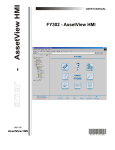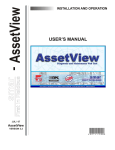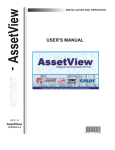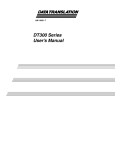Download DT302 - Smar
Transcript
www.smar.com Specifications and information are subject to change without notice. Up-to-date address information is available on our website. web: www.smar.com/contactus.asp DT302 – AssetView HMI DT302 - ASSETVIEW HMI DT302 – Home page This manual describes the pages developed for DT302 maintenance using AssetView. The figure below shows the DT302 initial page and its options: Figure 1 – Home page The following sub-sections will describe each one of the pages developed for the device maintenance. DT302 - Identification Page This page displays relevant information about the density transmitter. The user can easily identify and specify the transmitter in the physical plant. 3 User’s Manual Figure 2 – Identification page Device TAG Indicates the tag associated to the transmitter in the physical plant. The tag can have up to 8 characters. DEVICE TYPE Identifies the transmitter type for a specific manufacturer. DEVICE SERIAL NUMBER Indicates the transmitter serial number. DEVICE REVISION Indicates the transmitter revision. HARDWARE REVISION Indicates the transmitter hardware revision. DEVICE ID Indicates the transmitter identification code. This code can have up to 32 characters. MANUFACTURER Identifies the transmitter manufacturer. MAIN BOARD SERIAL NUMBER Indicates the serial number of the transmitter main board. FIRMWARE REVISION Indicates the transmitter firmware revision. DD REVISION Indicates the DD revision. ORDERING CODE Indicates the transmitter ordering code. Sensor 4 SENSOR TYPE Indicates the transmitter sensor type. SENSOR FLUID Indicates the fluid of the transmitter’s sensor. SENSOR RANGE CODE Indicates the range code of the transmitter’s sensor. SENSOR ISOLATION MATERIAL Indicates the sensor isolation material. SENSOR SERIAL NUMBER Indicates the transmitter sensor serial number. DT302 – AssetView HMI Probe DIAPHRAGM MATERIAL PROCESS CONNECTION MOUNTING MODEL TYPE FILL FLUID Indicates the diaphragm material. Indicates the process connection’s type, the transmitter can have 2, 3 or 4 wires. Indicates the field mounting type. Indicates the transmitter model type. Indicates the cell’s fluid. DT302 - Configuration Page The density transmitter DT302 has a complete set of fieldbus commands to access any feature implemented. The configuration page allows the user to configure the device’s parameters such as input limits, ranges adjustments, configuration of the linearization table, among others Figure 3 – Configuration page 5 User’s Manual Device Operation Mode Indicates the operation mode for the device: OOS If this mode is selected, the value of the Mode Block parameter will be Out of Service for the Resource, Transducer and Analog Output blocks. AUTO If this mode is selected, the value of the Mode Block parameter will be Auto for the Resource, Transducer, Display and Analog Output blocks. MAN If this mode is selected, the value of the Mode Block parameter will be Manual for the Analog Output block, and Auto for the Resource, Transducer and Display blocks. Measurement Configuration PV UNIT Unit of the process variable. PV LOWER RANGE Lower limit of the process variable. PV UPPER RANGE Upper limit of the process variable. MEASURED TYPE Specifies the measured type for concentration and density. MOUNTING POSITION Indicates the probe mounting position (direct or reverse). EU UNIT Engineering unit. EU 0% Value of the pressure corresponding to 0%, in EU. EU 100% Value of the pressure corresponding to 100%, in EU. TRANSDUCER TYPE Indicates the transducer type according to its class. Alert Configuration MAXIMUM OFFSET DEVIATION Indicates the maximum offset deviation before an alarm is generated. OVERPRESSURE LIMIT Defines the maximum overpressure limit before an alarm is generated. MAXIMUM GAIN DEVIATION Defines the maximum gain deviation before an alarm is generated. MAXIMUM NUMBER OF OVERPRESSURE Defines the maximum number of overpressure before an alarm is generated. Solid Polynomial 6 LIMIT LO Lower limit in solid percent. LIMIT HI Upper limit in solid percent. COEFF 0 Solid percent polynomial coefficient 0. COEFF 1 Solid percent polynomial coefficient 1. COEFF 2 Solid percent polynomial coefficient 2. COEFF 3 Solid percent polynomial coefficient 3. COEFF 4 Solid percent polynomial coefficient 4. COEFF 5 Solid percent polynomial coefficient 5. DT302 – AssetView HMI Constants Parameters GRAVITY Gravity acceleration used calculation. The unit is m/s². HEIGHT Distance between the two pressure sensors. The engineering units have to be compatible with IN_1 and IN_2. If are in mmH2O, the EU of height is in mm. LIN DILATATION COEFF Indicates the linear dilatation coefficient. PRESS COEFF Indicates the pressure coefficient. TEMP ZERO Offset coefficient temperature. TEMP GAIN Gain coefficient temperature. ZERO ADJ TEMP Temperature of zero adjustment. HEIGHT MEAS TEMP Temperature of measurement of distance between the pressure sensors. used used in concentration/density to calibrate the transmitter to calibrate the transmitter 7 User’s Manual DT302 - Diagnostics Page The user can check the general status diagnostic in the DT302 Diagnostic Page. Figure 4 – Diagnostics page Device Status MAXIMUM PRESSURE MEASURED MAXIMUM TEMPERATURE MEASURED CURRENT OFFSET CURRENT SPAN Indicates the maximum pressure measured. Indicates the minimum temperature measured. Indicates the calibration current offset. Indicates the calibration current span. DT302 - Calibration Page This page displays configuration data used in the calibration procedures. Figure 5 – Calibration page 8 DT302 – AssetView HMI Pressure Calibration Information CALIBRATION UNIT Indicates the unit for the pressure calibration procedure. SENSOR LOWER RANGE LIMIT Indicates the lower limit for the range’s sensor. SENSOR UPPER RANGE LIMIT Indicates the upper limit for the range’s sensor. MINIMUM SPAN Indicates the minimum value allowed between the lower and upper points of the calibration. CURRENT LOWER POINT CALIBRATION Indicates the current lower point of the pressure calibration. CURRENT HIGHER POINT CALIBRATION Indicates the current higher point of the pressure calibration. FACTORY LOWER POINT CALIBRATION Indicates the factory’s lower point of the pressure calibration. FACTORY HIGHER POINT CALIBRATION Indicates the factory’s higher point of the pressure calibration. PRESSURE MEASURED Indicates the pressure measured by the device. TEMPERATURE MEASURED Indicates the temperature measured by the device. Temperature Calibration Information CALIBRATION TEMPERATURE Indicates the value of the last temperature calibration. Calibration Information WHO Indicates the responsible for the last sensor calibration. DATE Indicates the date of the last sensor calibration. LOCATION Indicates the location of the last sensor calibration. LAST CALIBRATION TYPE Indicates the procedure of the last sensor calibration. Calibration Methods NOTE When the transmitter is installed, it is recommended to run the Lower Concentration Calibration procedure to minimize the mounting. Please refer to the transmitter manual for further details. LOWER CONCENTRATION CALIBRATION This method is used when calibrating the lower density point. The user can select the calibration unit and type the value of the density applied as reference value to the transmitter, observing the sensor limits and the minimum span. When this method is selected, a message appears warning the user that this procedure must be executed when the process stops or the plant control is set to manual. Click Yes, apply the density and wait for the sensor stabilization. 9 User’s Manual Figure 6 – Stabilizing the sensor Click OK, and the density measured will be shown. Figure 7 – Confirming the Value of the Density If the value is correct, click Yes to conclude this procedure. Otherwise, click No and type the density value: Figure 8 – New Density Value Click OK to apply the new density value, and then click Yes to confirm the alteration, as shown in the last figure. The calibration procedure will be concluded. UPPER CONCENTRATION CALIBRATION This method is similar to the Lower Concentration Calibration procedure described above. It is used when calibrating the density with the user’s reference instead of the manufacturer’s reference. Click Yes, apply the density and wait for the sensor stabilization. Figure 9 – Stabilizing the sensor Click OK, and the density measured will be shown. 10 DT302 – AssetView HMI Figure 10 – Confirming the Value of the Density If the value is correct, click Yes to conclude this procedure. Otherwise, click No and type the density value: Figure 11 – New Density Value Click OK to apply the new density value, and then click Yes to confirm the alteration, as shown in the last figure. The calibration procedure will be concluded. TEMPERATURE CALIBRATION This method is used for sensor temperature calibration. Click Ok, apply the temperature and wait for the sensor stabilization. Figure 12 - Stabilizing the Temperature Click OK to start the calibration. The temperature measured will be shown. Figure 13 - Confirming the Value of the Temperature If the value is correct, click Yes to conclude this procedure. Otherwise, click No and type the temperature value: 11 User’s Manual Figure 14 - New Temperature Value Click OK to apply the new temperature value, and then click Yes to confirm the alteration, as shown in the last figure. The calibration procedure will be concluded. DT302 – Display page The user can configure the data that will be shown in the device's display. Figure 15 – Display Page Display Options 12 BLOCK TAG Shows the tags list of the available instantiated blocks. PARAMETER Shows the list of available parameters to be displayed in the LCD for the selected block in the Block Tag option. SUB INDEX Indicates the sub-index of the selected parameter. MNEMONIC Indicates the mnemonic of the selected parameter in the Parameter option. INC DEC Indicates the value to be added or subtracted when acting the parameter via local adjustment. DECIMAL POINT NUMB Indicates the number of digits after the decimal point that will be shown in the LCD. ACCESS The user can select the access type of the selected parameter: monitoring or action. ALPHA NUM Indicates if the alphanumeric field will be used for mnemonic or for value.





















